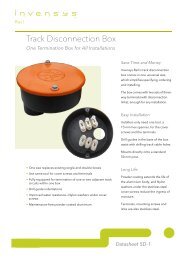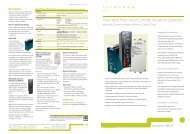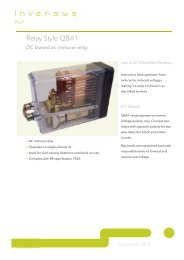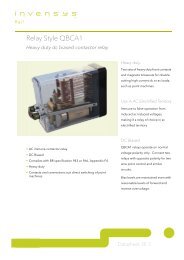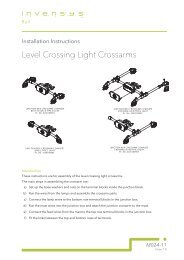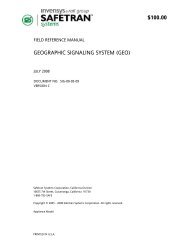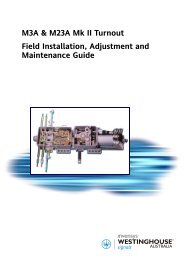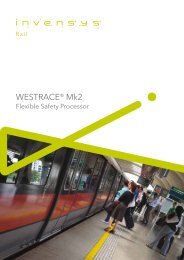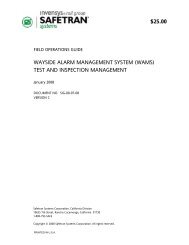Total Cost of Ownership of Rail Signalling Systems ... - Invensys Rail
Total Cost of Ownership of Rail Signalling Systems ... - Invensys Rail
Total Cost of Ownership of Rail Signalling Systems ... - Invensys Rail
Create successful ePaper yourself
Turn your PDF publications into a flip-book with our unique Google optimized e-Paper software.
<strong>Total</strong> <strong>Cost</strong> <strong>of</strong> <strong>Ownership</strong> <strong>of</strong> <strong>Rail</strong> <strong>Signalling</strong> <strong>Systems</strong> <strong>Total</strong> <strong>Cost</strong> <strong>of</strong> <strong>Ownership</strong> <strong>of</strong> <strong>Rail</strong> <strong>Signalling</strong> <strong>Systems</strong><br />
18<br />
Lessons from field<br />
engineer motivation:<br />
• Making field engineers accountable for<br />
performance is empowering. Field engineers<br />
need to feel their efforts have consequences<br />
both good (appealing to pride) and bad<br />
(appealing to competitiveness).<br />
• Monthly progress updates motivates continued<br />
effort. The pressure needs to be kept on.<br />
• Comparisons encourage collaboration between<br />
crews this leads to innovation (in protocols and<br />
regimes) and faster/ more effective problem<br />
resolution. Engineers are naturally curious folk<br />
and have an appetite to learn.<br />
• Discretion to use minor capital works budgets.<br />
The maintenance crews were given flexibility on<br />
how best they could use a fixed capital budget.<br />
This meant they had to think smartly about how<br />
they used this resource – for tools, signalling<br />
cards, or even better transport to get to site.<br />
• Financial incentives can provide a further boost<br />
to performance improvement. After a while,<br />
3 years at Operator B, failure rate improvement<br />
slowed down. This is partly because there is a<br />
natural limit to the level <strong>of</strong> improvement from<br />
doing things consistently well. But possibly<br />
also because pride and competitiveness<br />
can only be leveraged so far. The team at<br />
Operator B is in the process <strong>of</strong> designing a<br />
better compensation system that will reward<br />
improved performance, this will hopefully help<br />
to sustain the journey <strong>of</strong> improvement.<br />
Figure 11: Reduction in signalling failures after<br />
a 3-pronged solution<br />
Number <strong>of</strong> annual failures<br />
600<br />
500<br />
400<br />
300<br />
200<br />
100<br />
0<br />
Source: Operator C<br />
Reducing delays<br />
through technology<br />
2005 2006 2007 2008 2009<br />
Operator C implemented a series <strong>of</strong> measures<br />
to reduce delays on one <strong>of</strong> their worst-performing<br />
metro routes. The route was under five years old<br />
and had failed to attract the passenger ridership<br />
that it was designed to take. This had not been<br />
helped by the poor reputation that the route<br />
had developed for being unreliable.<br />
The solution Operator C implemented was<br />
led by engineering and involved three steps.<br />
The first step was to improve resilience and<br />
iron out teething problems with the original<br />
implementation – additional power supplies,<br />
hardware and a s<strong>of</strong>tware refresh. The second<br />
step was to make more <strong>of</strong> their engineers<br />
available during peak hours to resolve failures.<br />
The final step was to introduce asset condition<br />
monitoring to alert field engineers to potential<br />
failures before they occurred, an early warning<br />
system. They decided to trial the solution first.<br />
The condition monitoring sensors were retro-fitted<br />
to existing components. The engineers focused<br />
on the most critical components for the trial:<br />
those that were hard to reach, exposed to<br />
lightning strikes or intensely used. This allowed<br />
them to limit the scope <strong>of</strong> the trial and take<br />
maximum advantage <strong>of</strong> the benefits.<br />
Early indications are positive; see chart 12 –<br />
failures have declined dramatically since 2005.<br />
The operator confirms that the 3-pronged<br />
approach has reduced the number <strong>of</strong> delays<br />
affecting passengers. It has helped to increase<br />
ridership on the line which Operator C, who<br />
also operates the trains, is delighted with.<br />
95%<br />
Step 1: S<strong>of</strong>tware fixes<br />
and resolution <strong>of</strong><br />
teething problems<br />
Step 2 & 3:<br />
Condition based<br />
monitoring and<br />
improved monitoring<br />
and improved<br />
engineer response<br />
Key facts: condition-based<br />
monitoring technologies<br />
• A concept that is widespread in process<br />
industries such petrol refining where the<br />
impact <strong>of</strong> a failed component can halt<br />
production or create a safety hazard, both<br />
<strong>of</strong> which entail significant cost<br />
• The concept exploits the fact that any<br />
electrical component can communicate<br />
information about its status (current, vibration,<br />
temperature, the number <strong>of</strong> operations<br />
performed etc) that can be used to predict<br />
imminent failure, indicate operation beyond<br />
expected norms or can simply isolate a<br />
component that has already failed. The status<br />
signals can be fed back to a control centre that<br />
monitors unusual patterns and alerts engineers<br />
to intervene even sometimes before the<br />
component has failed<br />
• For example, points are prone to failure as<br />
they have moving parts. If a set <strong>of</strong> points starts<br />
to operate slower, or draw more current,<br />
performance trends can be computed to<br />
indicate an imminent fault. This can create<br />
a failure log for the maintenance crew to be<br />
called out with an appropriate level <strong>of</strong> priority<br />
• A simpler approach to condition-based<br />
monitoring is to simply record the number<br />
<strong>of</strong> operations an asset has experienced. For<br />
example, the number <strong>of</strong> trains that have passed<br />
over it. Linking this usage data with statistical<br />
data that can predict when a particular asset is<br />
most likely to fail, allows engineers to intervene<br />
ahead <strong>of</strong> actual failures. This approach has the<br />
advantage <strong>of</strong> being simpler and less capital<br />
intensive as the implementation does not<br />
require sensors to be retro-fitted to assets<br />
• A powerful next step would be to link performance<br />
data to the asset register to provide an integrated<br />
view <strong>of</strong> asset performance. This can help uncover<br />
systemic issues. For example, recurring failures<br />
isolated to a single component could point<br />
to an issue that goes beyond the component,<br />
possibly related to the track configuration or<br />
environmental factors.<br />
• Condition-based monitoring points to a new<br />
approach to maintenance – one that is driven<br />
by focussed intervention rather than routine<br />
inspections. The concept is being embraced<br />
by the UK rail infrastructure owner as part <strong>of</strong><br />
its move to an ‘Intelligent Infrastructure’.<br />
Given the material cost <strong>of</strong> maintenance, in<br />
UK rail this is delivered by c.15,000 engineers,<br />
a smarter approach to maintenance could<br />
make a material impact on both reliability<br />
and operating costs.<br />
I300203_<strong>Invensys</strong>_<strong>Cost</strong>Of<strong>Ownership</strong>_WhitePaper.indd 18-19 13/04/2010 15:11<br />
19





